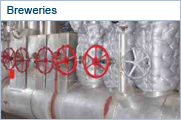Trias Energetica
Trias Energetica is a three-step plan intended to help companies, households and government institutions towards becoming climate-neutral.
The three steps are:
1. Reduce energy demands; energy savings through
good insulation for example.
2. Use sustainable energy sources, for example:
sun, wind and biomass-energy
3. Efficient use of fossil fuel: for example heat
recycling installations.
The three steps are:
1. Reduce energy demands; energy savings through
good insulation for example.
2. Use sustainable energy sources, for example:
sun, wind and biomass-energy
3. Efficient use of fossil fuel: for example heat
recycling installations.
Energy costs Research shows that for every Euro spent on energy, 8 eurocents are wasted through pipes and equipment that are exposed or insufficiently insulated. Even where it ‘looks’ as though something is insulated, loss through heat leakage can be considerable. This can happen when sheet metal cladding come into contact with pipes or seals, leading to heat transmission. Hot spots can easily be found by touch or using a thermographic camera. A good way to prevent hot spots from forming is to use prefab insulation blankets. (from: Het Ketelhuis – productie en gebruik van stoom in de praktijk” – Author N.D. Duinkerken). Good insulation can drastically reduce energy bills! This applies to both industry and non-residential buildings. It is incomprehensible that many companies invest heavily in heat recovery from exhausts and improvements to furnace operations, with costs that takes years to recover, yet these same companies show little interest in prevention of heat loss through bad or non-existent insulation of pipes, ancillaries and vats. Cost recovery on insulation takes months instead of years.
E-Bench energy monitoring E-Bench energy monitoring calculated energy usage for one of Thermatras’ clients. Measurements were carried out both prior to insulating the ancillaries and after insulation had taken place. The conclusion was that insulation blankets can achieve a savings of 7%. This equates to a cost savings of €5,000.00 annually, leading to a cost recovery of the investment within two years. Below is a graph clearly illustrating energy savings using insulation blankets (blue) as opposed no insulation (green):
Calculations indicating heat loss The VDI-Wärmeatlas is an oft-used reference word for heat loss calculations. The general rule of thumb is that heat loss on non-insulated pipes varies between 50 to 70% depending on the diameter of the pipe. Heat loss through exposed seals is between two to three times that of a non-insulated flange. This is the same as 1.5 to 2m of bare piping.
Insulation can reduce energy loss considerably. Heat loss reduction through insulated versus exposed pipes can be as much as 90 to 95%. For ancillaries, this yield is between 80 to 85% (from: Het Ketelhuis – productie en gebruik van stoom in de praktijk” – Author N.D. Duinkerken.)











